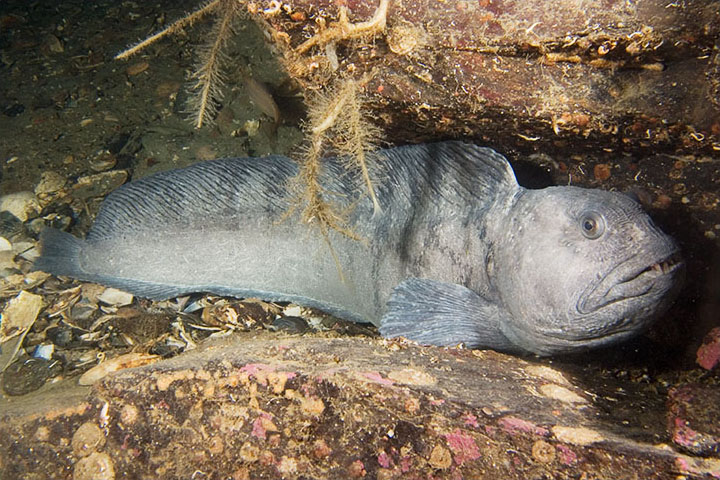fish
Junior Member Rank 1
 Spaced-out Hatchetfish
Spaced-out Hatchetfish
Posts: 45
|
Post by fish on Apr 5, 2014 2:30:02 GMT 5
 The green moray, Gymnothorax funebris, is a moray eel of the family Muraenidae, found in the western Atlantic from New Jersey, Bermuda, and the northern Gulf of Mexico to Brazil. The teeth of the green moray are large, smooth edged and easy to see when the jaws are agape. Towards the front of the upper jaw can be found two rows of teeth although along the rear of the jaw there is only one. The green moray feeds mostly at night on fishes, crabs, shrimp, octopuses, and squid. It is one of the largest morays. Maximum reported size for the species is 8 ft (2.5m) and 63 pounds (29 kg). Average maximum size is likely closer to 6 ft (1.8m) and 30 pounds (13.3 kg).  The Atlantic wolffish (Anarhichas lupus) is a marine fish, the largest of the wolffish family Anarhichadidae. Its body is long, subcylindrical in front, compressed in the caudal portion, smooth and slippery, the rudimentary scales being embedded and almost hidden in the skin. The Atlantic wolffish's distinguishing feature, from which it gets its common name, is its extensive teeth structure. Both the lower and upper jaws are armed with four to six fang-like, strong, conical teeth. Behind the conical teeth in the upper jaw, there are three rows of crushing teeth. The central row has four pairs of molars and the outer rows house blunted conical teeth. The lower jaw has two rows of molars behind the primary conical teeth. The wolffish's throat is also scattered with serrated teeth. The largest specimen recorded measured 150 cm (almost 5 ft) long and weighed 23 kg (50 lbs).   |
|
fish
Junior Member Rank 1
 Spaced-out Hatchetfish
Spaced-out Hatchetfish
Posts: 45
|
Post by fish on Apr 5, 2014 2:38:03 GMT 5
Getting a look at the wolffish jaws inspired me to make this match. Its quite impressive with both sharp fangs and lots of blunt teeth for crushing. The wolffish looks to also the more robust of the two, considering a heavier recorded weight at a smaller length (5 feet/50 lbs to 6 feet/30 lbs). But of course the moray is a more active predator almost certainly quicker than the bottom-dwelling wolffish and we all know what the eels jaws are like.
|
|
Deleted
Deleted Member
Posts: 0
|
Post by Deleted on Jan 31, 2016 16:45:08 GMT 5
Considering that the moray is longer than the wolffish yet weighs around the same, I would probably assume that the wolffish is perhaps the more resilient of the two and perhaps stronger? But I generally think that in situations that take place in the air or underwater, the smaller (as long as the size discrepancy isn't so big) or more flexible opponent should have the advantage most of the time as they would be in an environment where both can move easier in contrast to land. There is more of a chance that an opponent could actually dodge and counter attacks. This advantage goes to the moray IMO, whose morphology is more suited for flexibility than the wolffish, and it is also the more active predator. This is an example of what I am talking about: www.youtube.com/watch?feature=player_embedded&v=9X1rAeVt8OsThe wolffish probably has the stronger bite, but that doesn't mean it necessarily has a better bite. A look at injuries from morays:   It's also worth noting that morays are somewhat venomous. --- My vote goes to the eel, around 7 or 8/10. |
|
Deleted
Deleted Member
Posts: 0
|
Post by Deleted on Apr 7, 2018 7:23:03 GMT 5
This seems pretty even to me, though the moray appears to be more dangerous.
|
|
|
|
Post by dinosauria101 on Feb 12, 2019 1:13:36 GMT 5
This one's pretty fair, I agree. Whoever gets the 1st bite should win
|
|










